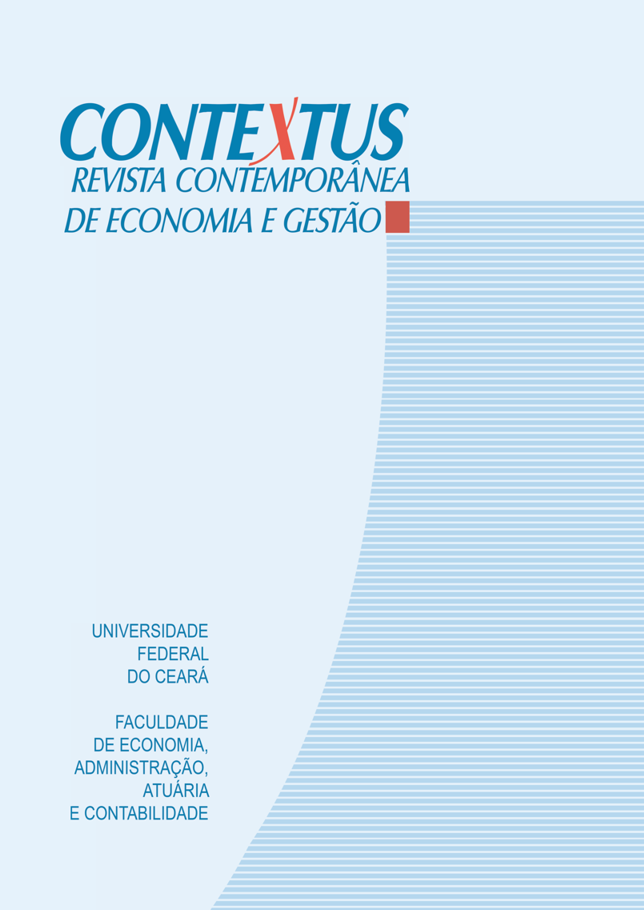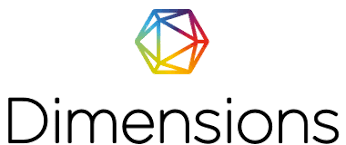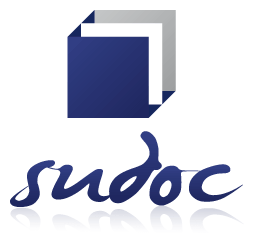Intensificação do trabalho: Rumo ao mapeamento do campo de estudos e definição de agenda de pesquisa
DOI:
https://doi.org/10.19094/contextus.2022.72844Palavras-chave:
intensificação do trabalho, bibliometria, cientometria, citespace, análise de conteúdoResumo
A intensificação do trabalho pode ser definida como o aumento do gasto de energia por parte do trabalhador no exercício de suas correntes ocupações. Diante da complexidade do fenômeno, este trabalho objetivou analisar a literatura científica sobre intensificação do trabalho com vistas a mapear o campo e propor uma agenda de pesquisa. A partir de 98 artigos extraídos da Web of Science foram desenvolvidas três abordagens, a saber: análises bibliométrica, cientométrica e de conteúdo. Os achados revelam que a produção científica sobre o tema teve um aumento significativo entre 2010 e 2019; que temas predominantes são conflito trabalho-família, esforço repetitivo, teletrabalho, entre outros. A agenda de pesquisa descortina ricas possibilidades de lacunas e estudos futuros para a área.
Referências
Afshari, L., Hayat, A., Ramachandran, K. K., Bartram, T., & Balakrishnan, B. K. P. D. (2022). Threat or opportunity: accelerated job demands during COVID-19 pandemic. Personnel Review, Vol. ahead. https://doi.org/10.1108/PR-02-2021-0098
Akamangwa, N. (2016). Working for the environment and against safety: How compliance affects health and safety on board ships. Safety Science, 87, 131-143. https://doi.org/10.1016/j.ssci.2016.03.027
Alberti, G., & Danaj, S. (2017). Posting and agency work in British construction and hospitality: the role of regulation in differentiating the experiences of migrants. International Journal of Human Resource Management, 28(21), 3059-3082. https://doi.org/10.1080/09585192.2017.1365746
Alfes, K., Shantz, A. D., & Ritz, A. (2018). A multilevel examination of the relationship between role overload and employee subjective health: The buffering effect of support climates. Human Resource Management, 57(2), 659-673. https://doi.org/10.1002/hrm.21859
Ali, F., Malik, A., Pereira, V., & Al Ariss, A. (2017). A relational understanding of work-life balance of Muslim migrant women in the west: future research agenda. International Journal of Human Resource Management, 28(8), 1163-1181. https://doi.org/10.1080/09585192.2016.1166784
Araújo, C. A. (2006). Bibliometria: evolução histórica e questões atuais. Em Questão, 12(1), 11-32. Retrieved from https://www.seer.ufrgs.br/EmQuestao/article/view/16
Bacon, N., Blyton, P., & Dastmalchian, A. (2010). The impact of organizational change on steelworkers in craft and production occupational groups. Human Relations, 63(8), 1223-1248. https://doi.org/10.1177/0018726709356599
Bathini, D. R., & Kandathil, G. M. (2019). An orchestrated negotiated exchange: Trading home-based telework for intensified work. Journal of Business Ethics, 154(2), 411-423. https://doi.org/10.1007/s10551-017-3449-y
Beckmann, M., Cornelissen, T., & Kräkel, M. (2017). Self-managed working time and employee effort: Theory and evidence. Journal of Economic Behavior and Organization, 133, 285-302. https://doi.org/10.1016/j.jebo.2016.11.013
Benoliel, P., & Somech, A. (2014). The health and performance effects of participative leadership: Exploring the moderating role of the Big Five personality dimensions. European Journal of Work and Organizational Psychology, 23(2), 277-294. https://doi.org/10.1080/1359432X.2012.717689
Bhardwaj, S., Bhattacharya, S., Tang, L., & Howell, K. E. (2019). Technology introduction on ships: The tension between safety and economic rationality. Safety Science, 115, 329-338. https://doi.org/10.1016/j.ssci.2019.02.025
Bhattacharya, S., & Tang, L. (2013). Fatigued for safety? Supply chain occupational health and safety initiatives in shipping. Economic and Industrial Democracy, 34(3), 383-399. https://doi.org/10.1177/0143831X12439760
Bigi, M., Greenan, N., Hamon-Cholet, S., & Lanfranchi, J. (2018). The human sustainability of ICT and management changes: Evidence for the French public and private sectors. Sustainability (Switzerland), 10(10), 1-23. https://doi.org/10.3390/su10103570
Blackman, I., Lye, C. Y., Darmawan, I. G. N., Henderson, J., Giles, T., Willis, E., Toffoli, L., Xiao, L., Verrall, C. (2018). Modeling Missed Care: Implications for Evidence-Based Practice. Worldviews on Evidence-Based Nursing, 15(3), 178-188. https://doi.org/10.1111/wvn.12285
Bloomfield, B., & Dale, K. (2015). Fit for work? Redefining ‘Normal’ and ‘Extreme’ through human enhancement technologies. Organization, 22(4), 552-569. https://doi.org/10.1177/1350508415572507
Boltanski, L., & Chiapello, E. (2009). O Novo Espírito do Capitalismo. Martins Fontes.
Bornmann, L., & Leydesdorff, L. (2013). Macro-Indicators of Citation Impacts of Six Prolific Countries: InCites Data and the Statistical Significance of Trends. PLoS ONE, 8(2), 1-5. https://doi.org/10.1371/journal.pone.0056768
Boxall, P., & Macky, K. (2014). High-involvement work processes, work intensification and employee well-being. Work, Employment and Society, 28(6), 963-984. https://doi.org/10.1177/0950017013512714
Bozkurt, Ö. (2015). The punctuation of mundane jobs with extreme work: Christmas at the supermarket deli counter. Organization, 22(4), 476-492. https://doi.org/10.1177/1350508415572512
Briskin, L. (2012). Resistance, mobilization and militancy: Nurses on strike. Nursing Inquiry, 19(4), 285-296. https://doi.org/10.1111/j.1440-1800.2011.00585.x
Broadbent, K. (2014). ‘I’d rather work in a supermarket’: privatization of home care work in Japan. Work, Employment and Society, 28(5), 702-717. https://doi.org/10.1177/0950017013500113
Brown, M. (2012). Responses to work intensification: Does generation matter? International Journal of Human Resource Management, 23(17), 3578-3595. https://doi.org/10.1080/09585192.2011.654348
Bullough, R. V, Hall-kenyon, K. M., Mackay, K. L., & Marshall, E. E. (2014). Head start and the intensification of teaching in early childhood education. Teaching and Teacher Education, 37, 55-63. https://doi.org/10.1016/j.tate.2013.09.006
Bunner, J., Prem, R., & Korunka, C. (2018). How work intensification relates to organization-level safety performance: The mediating roles of safety climate, safety motivation, and safety knowledge. Frontiers in Psychology, 9, 1-13. https://doi.org/10.3389/fpsyg.2018.02575
Burns, D. J., Hyde, P. J., & Killett, A. M. (2016). How financial cutbacks affect the quality of jobs and care for the elderly. Industrial and Labor Relations Review, 69(4), 991-1016. https://doi.org/10.1177/0019793916640491
Caretta, M. A., Drozdzewski, D., Jokinen, J. C., & Falconer, E. (2018). “Who can play this game?” The lived experiences of doctoral candidates and early career women in the neoliberal university. Journal of Geography in Higher Education, 42(2), 261-275. https://doi.org/10.1080/03098265.2018.1434762
Castel, R. (1998). As metamorfoses da questão social: uma crônica do salário. Rio de Janeiro: Vozes.
Cavazotte, F., Heloisa Lemos, A., & Villadsen, K. (2014). Corporate smart phones: Professionals’ conscious engagement in escalating work connectivity. New Technology, Work and Employment, 29(1), 72-87. https://doi.org/10.1111/ntwe.12022
Chang, P. C., Wu, T., & Liu, C. L. (2018). Do high-performance work systems really satisfy employees? Evidence from China. Sustainability (Switzerland), 10(10), 15-18. https://doi.org/10.3390/su10103360
Chen, C. (2006). CiteSpace II: Detecting and Visualizing Emerging Trends and Transient Patterns in Scientific Literature. Journal of the American Society for Information Science and Technology, 57(3), 359-377. https://doi.org/10.1002/asi.20317
Chen, C., & Leydesdorff, L. (2014). Patterns of Connections and Movements in Dual-Map Overlays: A New Method of Publication Portfolio Analysis. Journal of the Association for Information Science and Technology, 65(2), 334-351. https://doi.org/10.1002/asi.22968
Chen, C., & Song, M. (2019). Visualizing a field of research: A methodology of systematic scientometric reviews. PLoS ONE, 14(10). https://doi.org/10.1371/journal.pone.0223994
Chesley, N. (2014). Information and communication technology use, work intensification and employee strain and distress. Work, Employment and Society, 28(4), 589-610. https://doi.org/10.1177/0950017013500112
Chirico, F. (2017). The forgotten realm of the new and emerging psychosocial risk factors. Journal of Occupational Health, 59(5), 433-435. https://doi.org/10.1539%2Fjoh.17-0111-OP
Cooke, F. L., Wang, J., & Bartram, T. (2019). Can a supportive workplace impact employee resilience in a high pressure performance environment? An investigation of the Chinese banking industry. Applied Psychology, 68(4), 695-718. https://doi.org/10.1111/apps.12184
Cunningham, I. (2016). Non-profits and the ‘hollowed out’ state: The transformation of working conditions through personalizing social care services during an era of austerity. Work, Employment and Society, 30(4), 649-668. https://doi.org/10.1177/0950017016636983
Cunningham, I., Baines, D., & Charlesworth, S. (2014). Government funding, employment conditions, and work organization in non-profit community services: A comparative study. Public Administration, 92(3), 582-598. https://doi.org/10.1111/padm.12060
Curley, C., & Royle, T. (2013). The degradation of work and the end of the skilled emotion worker at Aer Lingus: Is it all trolley dollies now? Work, Employment and Society, 27(1), 105-121. https://doi.org/10.1177/0950017012460317
Currie, J., & Eveline, J. (2011). E-technology and work/life balance for academics with young children. Higher Education, 62(4), 533-550. https://doi.org/10.1007/s10734-010-9404-9
Cushen, J. (2013). Financialization in the workplace: Hegemonic narratives, performative interventions and the angry knowledge worker. Accounting, Organizations and Society, 38(4), 314-331. https://doi.org/10.1016/j.aos.2013.06.001
Davel, E., & Alcadipani, R. (1990). Estudos críticos em Administração: a Produção científica brasileira nos anos 1990. RAE, 43(4), 72-85. https://doi.org/10.1590/S0034-75902003000400006
Druck, G. (2013). A precarização social do trabalho no Brasil: Alguns indicadores. In R. Antunes (Ed.), Riqueza e Miseria do Trabalho no Brasil (p. 448). São Paulo: Boitempo.
Duffield, C., Roche, M. A., Wise, S., & Debono, D. (2020). Harnessing ward-level administrative data and expert knowledge to improve staffing decisions: A multi-method case study. Journal of Advanced Nursing, 76(1), 287-296. https://doi.org/10.1111/jan.14207
Edgar, F., Geare, A., Zhang, J. A., & McAndrew, I. (2015). Mutual gains or conflicting outcomes? How HRM benefits professionals. International Journal of Manpower, 36(8), 1248-1265. https://doi.org/10.1108/IJM-12-2014-0254
Ehrnrooth, M., & Björkman, I. (2012). An integrative HRM process theorization: Beyond signalling effects and mutual gains. Journal of Management Studies, 49(6), 1109-1135. https://doi.org/10.1111/j.1467-6486.2012.01055.x
Ekberg, K., Pransky, G. S., Besen, E., Fassier, J.-B., Feuerstein, M., Munir, F., & Blanck, P. (2016). New business structures creating organizational opportunities and challenges for work disability prevention. Journal of Occupational Rehabilitation, 26(4), 480-489. https://doi.org/10.1007/s10926-016-9671-0
Elo, S., & Kyngäs, H. (2008). The qualitative content analysis process. Journal of Advanced Nursing, 62(1), 107-115. https://doi.org/10.1111/j.1365-2648.2007.04569.x
Esbenshade, J., Vidal, M., Fascilla, G., & Ono, M. (2016). Customer-driven management models for choiceless clientele? Business process reengineering in a California welfare agency. Work, Employment & Society, 30(1), 77-96. https://doi.org/10.1177/0950017015604109
Evenstad, S. B. N. (2018). The virtuous circle of ephemeralization and the vicious circle of stress: A systemic perspective on ICT worker burnout. Futures, 103, 61-72. https://doi.org/10.1177/0950017015604109
Farrell, C., & Morris, J. (2017). Neo-bureaucratic organisational forms, technology, control and contingent work: The case of UK TV. New Technology, Work and Employment, 32(2), 115-130. https://doi.org/10.1111/ntwe.12088
Felstead, A., & Henseke, G. (2017). Assessing the growth of remote working and its consequences for effort, well-being and work-life balance. New Technology, Work and Employment, 32(3), 195-212. https://doi.org/10.1111/ntwe.12097
Gascoigne, C., Parry, E., & Buchanan, D. (2015). Extreme work, gendered work? How extreme jobs and the discourse of ‘personal choice’ perpetuate gender inequality. Organization, 22(4), 457-475. https://doi.org/10.1177/1350508415572511
Gidman, W. (2011). Increasing community pharmacy workloads in England: Causes and consequences. International Journal of Clinical Pharmacy, 33(3), 512-520. https://doi.org/10.1007/s11096-011-9498-x
Green, F. (2004). Why has work effort become more intense? Industrial Relations, 43(4), 709-741. https://doi.org/10.1111/j.0019-8676.2004.00359.x
Hart, S. M., & Warren, A. M. (2015). Understanding nurses’ work: Exploring the links between changing work, labour relations, workload, stress, retention and recruitment. Economic and Industrial Democracy, 36(2), 305-329. https://doi.org/10.1177/0143831X13505119
Heffernan, M., & Dundon, T. (2016). Cross-level effects of high-performance work systems (HPWS) and employee well-being: The mediating effect of organisational justice. Human Resource Management Journal, 26(2), 211-231. https://doi.org/10.1111/1748-8583.12095
Huang, L., Zhou, M., Lv, J., & Chen, K. (2020). Trends in global research in forest carbon sequestration: A bibliometric analysis. Journal of Cleaner Production, 252, 119908. https://doi.org/10.1016/j.jclepro.2019.119908
Huo, M. L., Boxall, P., & Cheung, G. W. (2019). Lean production, work intensification and employee wellbeing: Can line-manager support make a difference? Economic and Industrial Democracy. https://doi.org/10.1177/0143831X19890678
Jolanki, O. (2015). To work or to care? Working women’s decision-making. Community, Work & Family, 18(3), 268-283. https://doi.org/10.1080/13668803.2014.997194
Karousiou, C., Hajisoteriou, C., & Angelides, P. (2019). Teachers’ professional identity in super-diverse school settings: teachers as agents of intercultural education. Teachers and Teaching: Theory and Practice, 25(2), 240-258. https://doi.org/10.1080/13540602.2018.1544121
Kelliher, C., & Anderson, D. (2010). Doing more with less? Flexible working practices and the intensification of work. Human Relations, 63(1), 83-106. https://doi.org/10.1177/0018726709349199
Kennedy, E. H., Krahn, H., & Krogman, N. T. (2013). Downshifting: An exploration of motivations, quality of life, and environmental practices. Sociological Forum, 28(4), 764-783. https://doi.org/10.1111/socf.12057
Keogh, M., & Roan, A. (2016). Exploring teachers’ early-retirement decisions: A qualitative study. Work, Aging and Retirement, 2(4), 436-446. https://doi.org/10.1093/workar/waw016
Korunka, C., Kubicek, B., Paškvan, M., & Ulferts, H. (2015). Changes in work intensification and intensified learning: Challenge or hindrance demands? Journal of Managerial Psychology, 30(7), 786-800. https://doi.org/10.1108/JMP-02-2013-0065
Kossek, E. E., Lewis, S., & Hammer, L. B. (2010). Work-life initiatives and organizational change: Overcoming mixed messages to move from the margin to the mainstream. Human Relations, 63(1), 3-19. https://doi.org/10.1177/0018726709352385
Koukoulaki, T., Pinotsi, D., Geogiadou, P., Daikou, A., Zorba, K., Targoutzidis, A.,Poulios, K., Naris, S., Panousi, P., Skoulatakis., Drivas, S., Kapsali, K., Pahkin, K. (2017). Restructuring seriously damages well-being of workers: The case of the restructuring programme in local administration in Greece. Safety Science, 100, 30-36. https://doi.org/10.1016/j.ssci.2017.06.002
Kubicek, B., Korunka, C., & Ulferts, H. (2013). Acceleration in the care of older adults: New demands as predictors of employee burnout and engagement. Journal of Advanced Nursing, 69(7), 1525-1538. https://doi.org/10.1111/jan.12011
Kubicek, B., Paškvan, M., & Korunka, C. (2015). Development and validation of an instrument for assessing job demands arising from accelerated change: The intensification of job demands scale (IDS). European Journal of Work and Organizational Psychology, 24(6), 898-913. https://doi.org/10.1080/1359432X.2014.979160
Lawrence, D. F., Loi, N. M., & Gudex, B. W. (2019). Understanding the relationship between work intensification and burnout in secondary teachers. Teachers and Teaching: Theory and Practice, 25(2), 189-199. https://doi.org/10.1080/13540602.2018.1544551
Le Fevre, M., Boxall, P., & Macky, K. (2015). Which workers are more vulnerable to work intensification? An analysis of two national surveys. International Journal of Manpower, 36(6), 966-983. https://doi.org/10.1108/IJM-01-2014-0035
Lemos, A. H. C., Gottlieb, L. S. N., & Costa, A. S. M. (2016). Pressure, Performance and Prestige: Dilemmas for contemporary Professionals. Organizações & Sociedade, 23(79), 539-552. https://doi.org/10.1590/1984-9230791
Lindsay, C., Commander, J., Findlay, P., Bennie, M., Dunlop Corcoran, E., & Van Der Meer, R. (2014). ‘Lean’, new technologies and employment in public health services: employees’ experiences in the National Health Service. International Journal of Human Resource Management, 25(21), 2941-2956. https://doi.org/10.1080/09585192.2014.948900
Loh, J., & Hu, G. (2014). Subdued by the system: Neoliberalism and the beginning teacher. Teaching and Teacher Education, 41, 13-21. https://doi.org/10.1016/j.tate.2014.03.005
Mariappanadar, S. (2014). Stakeholder harm index: A framework to review work intensification from the critical HRM perspective. Human Resource Management Review, 24(4), 313-329. https://doi.org/10.1016/j.hrmr.2014.03.009
Mariappanadar, S. (2016). Health harm of work from the sustainable HRM perspective: Scale development and validation. International Journal of Manpower, 37(6), 924-944. https://doi.org/10.1108/IJM-12-2015-0204
Martín-Martín, A., Orduna-Malea, E., Ayllón, J. M., & Delgado López-Cózar, E. (2016). Back to the past: oOn the shoulders of an academic search engine giant. Scientometrics, 107(3), 1477-1487. https://doi.org/10.1007/s11192-016-1917-2
Mauno, S., Kubicek, B., Minkkinen, J., & Korunka, C. (2019). Antecedents of intensified job demands: Evidence from Austria. Employee Relations, 41(4), 694-707. https://doi.org/10.1108/ER-04-2018-0094
McDonald, K. S., & Hite, L. M. (2018). Conceptualizing and creating sustainable careers. Human Resource Development Review, 17(4), 349-372. https://doi.org/10.1177/1534484318796318
McGrath, S. (2013). Fuelling global production networks with slave labour?: Migrant sugar cane workers in the Brazilian ethanol GPN. Geoforum, 44, 32-43. https://doi.org/10.1016/j.geoforum.2012.06.011
Menezes, L. M. de. (2012). Job satisfaction and quality management: An empirical analysis. International Journal of Operations and Production Management, 32(3), 308-328. https://doi.org/10.1108/01443571211212592
Mingers, J., & Leydesdorff, L. (2015). A review of theory and practice in scientometrics. European Journal of Operational Research, 246(1), 1-19. https://doi.org/10.1016/j.ejor.2015.04.002
Moen, P., Lam, J., Ammons, S., & Kelly, E. L. (2013). Time Work by Overworked Professionals: Strategies in Response to the Stress of Higher Status. Work and Occupations, 40(2), 79-114. https://doi.org/10.1177/0730888413481482
Moore, P., & Piwek, L. (2017). Regulating wellbeing in the brave new quantified workplace. Employee Relations, 39(3), 308-316. https://doi.org/10.1108/ER-06-2016-0126
Moore, S., Onaran, O., Guschanski, A., Antunes, B., & Symon, G. (2019). The resilience of collective bargaining - a renewed logic for joint regulation? Employee Relations, 41(2), 279-295. https://doi.org/10.1108/ER-09-2018-0256
Morgan, G. (2005). Paradigmas, metáforas e resolução de quebra-cabeças na teoria das organizações. RAE - Revista de Administração de Empresas, 45(1), 58-71.
Mrčela, A. K., & Sadar, N. Č. (2011). Social policies related to parenthood and capabilities of slovenian parents. Social Politics, 18(2), 199-231. https://doi.org/10.1093/sp/jxr010
Neumann, W. P., & Medbo, L. (2010). Ergonomic and technical aspects in the redesign of material supply systems: Big boxes vs. narrow bins. International Journal of Industrial Ergonomics, 40(5), 541-548. https://doi.org/10.1016/j.ergon.2010.06.004
O’Donnell, M., Williamson, S., Adikaram, A., & Foley, M. (2019). Human resource managers as liaisons between firms and labour. Employee Relations, 41(6), 1224-1237. https://doi.org/10.1108/ER-11-2017-0281
Ochoa, P. (2018). Impact of burnout on organizational outcomes, the influence of legal demands: The case of Ecuadorian physicians. Frontiers in Psychology, 9, 1-11. https://doi.org/10.3389/fpsyg.2018.00662
Ogbonnaya, C., Daniels, K., Connolly, S., & van Veldhoven, M. (2017). Integrated and isolated impact of high-performance work practices on employee health and well-being: A comparative study. Journal of Occupational Health Psychology, 22(1), 98-114. https://doi.org/10.1037/ocp0000027
Ogbonnaya, C., Daniels, K., & Nielsen, K. (2017). Does contingent pay encourage positive employee attitudes and intensify work? Human Resource Management Journal, 27(1), 94-112. https://doi.org/10.1111/1748-8583.12130
Omari, M., & Paull, M. (2015). Public sector work intensification and negative behaviors. Journal of Organizational Change Management, 28(4), 603-613. https://doi.org/10.1108/JOCM-11-2013-0225
Page, D. (2015). Teachers’ personal web use at work. Behaviour and Information Technology, 34(5), 443-453. https://doi.org/10.1080/0144929X.2014.928744
Palmerud, G., Forsman, M., Neumann, W. P., & Winkel, J. (2012). Mechanical exposure implications of rationalization: A comparison of two flow strategies in a Swedish manufacturing plant. Applied Ergonomics, 43(6), 1110-1121. https://doi.org/10.1016/j.apergo.2012.04.001
Paškvan, M., Kubicek, B., Prem, R., & Korunka, C. (2016). Cognitive appraisal of work intensification. International Journal of Stress Management, 23(2), 124-146. https://doi.org/10.1037/a0039689
Patel, C., Budhwar, P., Witzemann, A., & Katou, A. (2019). HR outsourcing: the impact on HR’s strategic role and remaining in-house HR function. Journal of Business Research, 103, 397-406. https://doi.org/10.1016/j.jbusres.2017.11.007
Payne, J., Mcdonald, S., & Hamm, L. (2013). Production teams and producing racial diversity in workplace relationships. Sociological Forum, 28(2), 326-349. https://doi.org/10.1111/socf.12021
Peticca-Harris, A., Weststar, J., & McKenna, S. (2015). The perils of project-based work: Attempting resistance to extreme work practices in video game development. Organization, 22(4), 570-587. https://doi.org/10.1177/1350508415572509
Ramsay, H., Scholarios, D., & Harley, B. (2000). Employees and high-performance work systems: Testing inside the black box. British Journal of Industrial Relations, 38(4), 501-531. https://doi.org/10.1111/1467-8543.00178
Rosso, S. D. (2008). Mais trabalho! A intensificação do labor na sociedade contemporânea. São Paulo: Boitempo.
Russell, B., Smith, C., Valsecchi, R., & Andersson Bäck, M. (2017). System, society and dominance effects in the adoption of tele-health: A tri-country comparison. Economic and Industrial Democracy, 38(3), 425-447. https://doi.org/10.1177/0143831X15579287
Santos, R., & Kobashi, N. (2009). Bibliometria, cientometria, infometria: conceitos e aplicações. Pesquisa Brasileira em Ciência da Informação, 2(1), 155-172.
Scott, S. (2017). Informalisation in Low-wage Labour Markets: a Case Study of the UK Food Industry. Population, Space and Place, 23(7). https://doi.org/10.1002/psp.2043
Seing, I., MacEachen, E., Ekberg, K., & Ståhl, C. (2015). Return to work or job transition? Employer dilemmas in taking social responsibility for return to work in local workplace practice. Disability and Rehabilitation, 37(19), 1760-1769. https://doi.org/10.3109/09638288.2014.978509
Silla, I., & Gamero, N. (2018). Psychological safety climate and professional drivers’ well-being: The mediating role of time pressure. Transportation Research Part F: Traffic Psychology and Behaviour, 53, 84-92. https://doi.org/10.1016/j.trf.2017.12.002
Smith, A. (2016). ‘The Magnificent 7[am]?’ Work-life articulation beyond the 9[am] to 5[pm] ‘norm.’ New Technology, Work and Employment, 31(3), 209-222. https://doi.org/10.1111/ntwe.12070
Stanton, P., Gough, R., Ballardie, R., Bartram, T., Bamber, G. J., & Sohal, A. (2014). Implementing lean management/Six Sigma in hospitals: Beyond empowerment or work intensification? International Journal of Human Resource Management, 25(21), 2926-2940. https://doi.org/10.1080/09585192.2014.963138
Taylor, P., D’Cruz, P., Noronha, E., & Scholarios, D. (2014). “From boom to where?”: The impact of crisis on work and employment in Indian BPO. New Technology, Work and Employment, 29(2), 105-123. https://doi.org/10.1111/ntwe.12027
Teeple Hopkins, C. (2017). Work intensifications, injuries and legal exclusions for paid domestic workers in Montréal, Québec. Gender, Place and Culture, 24(2), 201-212. https://doi.org/10.1080/0966369X.2017.1298573
Tregaskis, O., Daniels, K., Glover, L., Butler, P., & Meyer, M. (2013). High performance work practices and firm performance: A longitudinal case study. British Journal of Management, 24(2), 225-244. https://doi.org/10.1111/j.1467-8551.2011.00800.x
Turnbull, P. J., & Wass, V. (2015). Normalizing extreme work in the Police Service? Austerity and the inspecting ranks. Organization, 22(4), 512-529. https://doi.org/10.1177/1350508415572513
van den Bossche, S., Taris, T., Houtman, I., Smulders, P., & Kompier, M. (2013). Workplace violence and the changing nature of work in Europe: Trends and risk groups. European Journal of Work and Organizational Psychology, 22(5), 588-600. https://doi.org/10.1080/1359432X.2012.690557
Venz, L., & Boettcher, K. (2021). Leading in times of crisis: How perceived COVID-19-related work intensification links to daily e-mail demands and leader outcomes. Applied Psychology, (October), 1-23. https://doi.org/10.1111/apps.12357
Wang, Z., Zhao, Y., & Wang, B. (2018). A bibliometric analysis of climate change adaptation based on massive research literature data. Journal of Cleaner Production, 199, 1072-1082. https://doi.org/10.1016/j.jclepro.2018.06.183
Wankhade, P., Stokes, P., Tarba, S., & Rodgers, P. (2020). Work intensification and ambidexterity - the notions of extreme and ‘everyday’ experiences in emergency contexts: surfacing dynamics in the ambulance service. Public Management Review, 22(1), 48-74. https://doi.org/10.1080/14719037.2019.1642377
White, M., & Smeaton, D. (2016). Older British employees’ declining attitudes over 20 years and across classes. Human Relations, 69(8), 1619-1641. https://doi.org/10.1177/0018726715618765
Willis, E., Harvey, C., Thompson, S., Pearson, M., & Meyer, A. (2018). Work Intensification and Quality Assurance: Missed Nursing Care. Journal of Nursing Care Quality, 33(2), 10-16. https://doi.org/10.1097/NCQ.0000000000000277
Willis, E., Toffoli, L., Henderson, J., Couzner, L., Hamilton, P., Verrall, C., & Blackman, I. (2016). Rounding, work intensification and new public management. Nursing Inquiry, 23(2), 158-168. https://doi.org/10.1111/nin.12116
Wilson, M., & Holligan, C. (2013). Performativity, work-related emotions and collective research identities in UK university education departments: An exploratory study. Cambridge Journal of Education, 43(2), 223-241. https://doi.org/10.1080/0305764X.2013.774321
Zhang, L. (2015). Lean Production “with Chinese Characteristics”: A case study of China’s Automobile Industry. International Journal of Sociology, 45(2), 152-170. https://doi.org/10.1080/00207659.2015.1061861
Zhou, W., Chen, J., & Huang, Y. (2019). Co-citation analysis and burst detection on financial bubbles with Scientometrics approach. Economic Research, 32(1), 2310-2328. https://doi.org/10.1080/1331677X.2019.1645716
Publicado
Como Citar
Edição
Seção
Licença
Os autores, no ato da submissão, aceitam a declaração abaixo:
Nós autores mantemos sobre nosso artigo publicado os direitos autorais e concedemos à revista Contextus o direito de primeira publicação, com uma licença Creative Commons na modalidade Atribuição – Não Comercial 4.0 Internacional, a qual permite o compartilhamento com reconhecimento da autoria e da publicação inicial nesta revista.
Temos ciência de estarmos autorizados a assumir contratos adicionais separadamente, para distribuição não exclusiva da versão do trabalho publicada nesta revista (ex.: publicar em repositório institucional ou como capítulo de livro), também com reconhecimento tanto da autoria, quanto da publicação inicial neste periódico.
Atestamos que o artigo é original ou inédito, não foi publicado, até esta data, em nenhum periódico brasileiro ou estrangeiro, quer em português, quer em versão em outra língua, nem está encaminhado para publicação simultânea em outras revistas.
Sabemos que o plágio não é tolerado pela revista Contextus e asseguramos que o artigo apresenta as fontes de trechos de obras citadas, incluindo os de qualquer trabalho prévio produzido e publicado pelos próprios autores.









3.png)


1.jpg)



1.jpg)


1.jpg)






.jpg)



1.jpg)

1.jpg)


1.jpg)

1.jpg)
1.jpg)
2.png)




1.jpg)
2.jpg)

1.jpg)





1.jpg)


1.jpg)
1.jpg)
